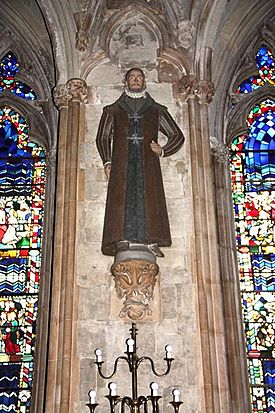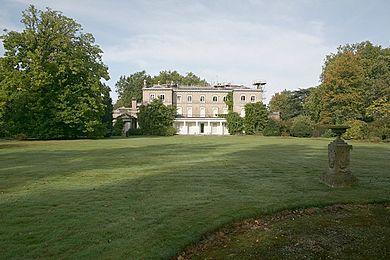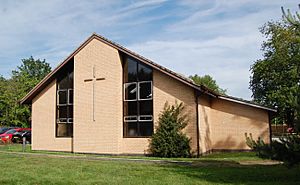Swithun Wells facts for kids
Quick facts for kids SaintSwithun Wells |
|
|---|---|

Statue of Swithun Wells in the St Etheldreda's Church, Ely Place, London
|
|
| Martyr | |
| Born | c. 1536 Brambridge House, Otterbourne, Hampshire |
| Died | 10 December 1591 (aged 54 - 55) Gray's Inn Lane, London |
| Venerated in | Roman Catholic Church |
| Beatified | 15 December 1929 by Pope Pius XI |
| Canonized | 25 October 1970 by Pope Paul VI |
| Feast | 10 December (individual) 25 October (collectively with Forty Martyrs of England and Wales) |
| Attributes | reading a book or holding a stack of books, falcon |
Swithun Wells (born around 1536, died December 10, 1591) was an English Catholic man. He was killed during the time of Queen Elizabeth I because of his faith. Swithun Wells was a gentleman and a teacher. His family helped hide Catholic priests who were being searched for. He also helped these priests travel safely from one secret house to another. His home in London was a known place for Catholics who practiced their faith in secret.
Contents
Who Was Swithun Wells?
Swithun Wells was born in 1536 at Brambridge House in Hampshire, England. His family was wealthy and well-known in the countryside. He was named after a local saint and bishop, Swithun. During the time of the Reformation, his family helped with secret burials for Catholics. Their home was also a safe place for priests who were in danger.
Swithun was a smart and talented person. He enjoyed poetry, music, and sports. He had traveled to Rome and could speak Italian. For some time, he worked as a tutor for the Earl of Southampton's family. He also taught at a school in Monkton Farleigh for many years.
In 1582, people started to suspect him because of his Catholic beliefs. He was ordered to be searched for, and he stopped teaching at the school. During this time, he attended Protestant church services. However, in 1583, he fully returned to the Catholic Church. He then actively helped Catholic priests. He would organize their risky journeys from one safe house to another. In 1585, he moved to London and bought a house in Gray's Inn Lane. His home became a welcoming place for Catholics who practiced their faith in secret.
Why Was Swithun Wells Arrested?
Swithun Wells was arrested several times because of his Catholic faith. In June 1586, he was put in Newgate Prison with two other Catholic students. He was released in July after his nephew paid bail for him.
Later, in August 1586, he was questioned about a plan called the Babington Plot. This plot was against Queen Elizabeth I. In November 1586, he was let out of Fleet prison. At one point, he went to Rome for the Earl of Southampton. But he came back to England to continue helping Catholics in secret. He was questioned again in March 1587.
In 1591, a Catholic priest named Edmund Gennings was holding a Mass at Swithun's house. A priest-hunter named Richard Topcliffe and his officers suddenly broke in. The people at the Mass did not want it to be stopped. They held the door closed and pushed back the officers until the service was finished. After the Mass, everyone surrendered peacefully. Swithun Wells was not there at the time, but his wife was. She, along with Father Gennings and another priest, Polydore Plasden, were arrested. Three other men were also arrested.
When Swithun Wells returned home, he was immediately arrested and put in prison. He was charged under a law from 1585. This law was against priests and others who did not follow the Queen's religious rules. At his trial, Swithun said he was not at the Mass, but he wished he had been.
The Death of Swithun Wells
Swithun Wells was sentenced to die by hanging. A gallows was set up outside his own house on December 10, 1591. As he walked to the gallows, Swithun saw an old friend in the crowd. He told his friend, "Goodbye my dear. Goodbye to our nice hunting companies. Now I have something much more important to do."
After he climbed the ladder, Richard Topcliffe called for a minister. The minister tried to make Swithun confess that he was following false teachings. Swithun turned and replied, "although I heard you say somewhat, yet it is but one doctor's opinion, and he also a very young one." The young minister was so surprised he had no answer. Topcliffe then tried to provoke Swithun with insults. Swithun responded back, but then immediately asked for forgiveness. He asked Topcliffe not to upset him when he was trying to focus on important matters. Swithun Wells was buried in St Andrew's Churchyard in Holborn.
His wife, Alice, was not executed but died in prison in 1602. Swithun's older brother, Gilbert, suffered greatly for his faith. He lost his property and died as a known Catholic who refused to change his beliefs. However, his family later got their property back from King Charles II.
Honoring Swithun Wells
Swithun Wells was recognized as a blessed person by Pope Pius XI on December 15, 1929. He was later made a saint by Pope Paul VI on October 25, 1970. He is one of the Forty Martyrs of England and Wales. Their feast day used to be October 25. However, since 2000, the Catholic Church in England and Wales celebrates all the saints and blessed martyrs from the Reformation Period on May 4. This date is called "The English Martyrs." The Anglican Church of England also celebrates English Saints and Martyrs from the Reformation Era on this same date.
There is a school named after him, St Swithun Wells Catholic Primary School. It is located in Chandler's Ford, near Eastleigh, Hampshire. A church, St Swithun Wells Church, opened in nearby Fair Oak in 1978. This church gives its name to the larger Catholic Parish of St Swithun Wells, which includes six Catholic churches in south and west Hampshire.



